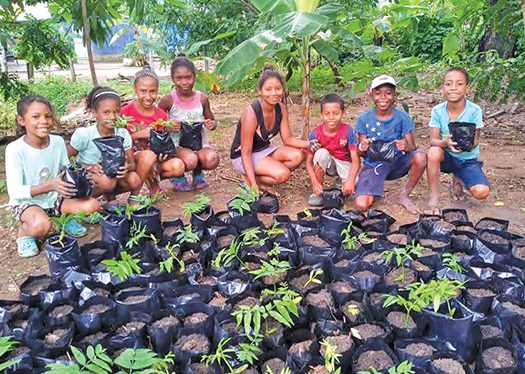
Aripao children with Dipteryx punctata tree seedlings ready for planting. (Photo courtesy of Phynatura)
When Venezuelan President Nicolás Maduro established the enormous Caura National Park in 2017, he was ostensibly safeguarding the 75,000-square-kilometer (29,000-sq.-mile) expanse of forest and moist savanna from mining, logging and the encroachment of agriculture.
But critics viewed the move as a ploy. Maduro a year earlier had issued a decree creating the National Orinoco Mining Arc Strategic Development Zone, a 120,000-square-kilometer (46,000-sq-mile) area earmarked for metals and mineral extraction north of the future park site and south of the Orinoco River.
Skeptics said that rather than reflecting a conservation commitment, the park was created to dampen environmental concerns about large-scale Mining Arc operations to dig out gold, diamonds, bauxite, nickel and more.
Whatever Maduro’s motivation, the park certainly did not offer much protection. The government’s promotion of mineral extraction as a means of replacing flagging oil revenues spurred mining into areas beyond the Arc, including Caura Park and other protected areas. (See "Once-vaunted parks system now in crisis" —EcoAméricas, April 2022.) “The whole of [Venezuela’s eastern region of] Guayana and the [Venezuelan] Amazon Biome are now considered part of the mining arc, despite their protected status,” says Luis Jiménez, who advises mining companies on environmental impact.
Agrees Elides Sulbarán, a forest engineer who worked for 30 years at the National Venezuelan Parks Institute (Inparques): “Although conservation is well established as a central axis of Venezuela’s 1999 constitution, this government’s silence in the face of environmental damage is deafening. Mining is fast encroaching into Caura National Park and the government policy is to turn a blind eye in the name of economic interests.”
Jiménez worked in the 1990s on projects to restore land damaged by mining in the Guayana region, which includes the Caura River basin encompassed by current-day Caura National Park. While doing so, he saw the need for local communities to find sustainable alternatives to mining. In 2005, he founded Phynatura, a nonprofit that aims to curb deforestation and illegal mining in the Guayana region. Jiménez notes that prior to their involvement in Phynatura, the Aripao and other Indigenous groups in the Caura River basin would travel to illegal mines in search of work or depend on illicit activities such as deforestation or hunting.
Mirage of mining
Says Jiménez: “The promise of mining made the Aripao think they would be able to take fortunes back to their communities, but the reality was that [illegal] mining operations exploited them and they often returned home with venereal diseases and malaria.”
To date, Phynatura has helped convert some 150,000 hectares (370,000 acres) of forest into conservation areas run by local Indigenous communities. The communities work to curb invasions by miners and loggers not only to protect the forest ecosystem, but also to enable sustainable economic activities that depend on it.
Key to the effort are economic connections fostered under the conservation agreements. An example is a 2009 accord Phynatura developed with the African-descended Aripao. It creates a conservation area called Suapure in what is now Caura National Park, close to the park’s northern border. The area represents 3% of the 50,000-square-kilometer (19,000-sq.-mile) basin of the Caura River, a major tributary of the Orinoco River.
Phynatura provided community training and education to build local capacity for forest stewardship and compatible business activity. In the process, it won the backing of communities, civil society, and the private sector.
Then Aripao community members organized themselves into a civil association to administer resources and implement projects, and Givaudan, a French perfume company, agreed to purchase tonka from the association. The almond-like bean of the sarrapia tree (Dipteryx punctata), tonka is valued for its aromatic properties. The association sells pre-agreed quantities to Givaudan, generating income to finance the Conservation Agreement.
The result, experts say, has been strong local support for forest protection. “The conservation agreement has engendered sound sustainable practices that keep illegal mining out because the locals are in situ to defend their territory,” says biologist Vilisa Morón, president of the Venezuelan Society for Ecology (SVE).
Knock-on benefits
Aside from financing the Conservation Agreement, the Givaudan funding also supports ongoing wildlife protection efforts and social services such as medical support for project workers and their families. Meanwhile, the Phynatura model has encouraged the sustainable planting and management of other endemic species, namely copaiba (Copaifera officinalis), cocoa (Theobroma cacao), copoazú (Theobroma grandiflorum), and acaí (Euterpe oleracea). The sale of these products has brought in additional income for the community.
“Whereas, before, a tree illegally felled could fetch around US$200, we have taught the communities how to commercialize the fruits so that each tree can now provide them with some [US] $200 of income per year,” Jiménez says.
Notes Morón, who has collaborated with many of the same Caura River basin communities: “When we work among the Aripao communities that are part of the Caura Conservation Agreement, it is clear they have received and understood sound environmental education and are committed to conservation.”
After the Aripao launched their initiative, they and Phynatura helped the nearby Indigenous community of La Colonial to design and implement its own conservation agreement. Today 60 Aripao families and another 24 families in La Colonial receive direct and indirect benefits from the sale of non-timber forest products and compensation for green monitoring activities. Jiménez is now trying to replicate the model in Sipao, in the Autana River basin, and in Kanaimó, a village in Canaima National Park. All such efforts will be uphill battles, in no small part due to bureaucratic hurdles and a lack of support from the national government.
- Lara Rodríguez
In the index: Sale of tonka beans to a French perfume manufacturer have funded the Aripao forest-conservation plan as well as wildlife protection. (Photo courtesy of Phynatura)